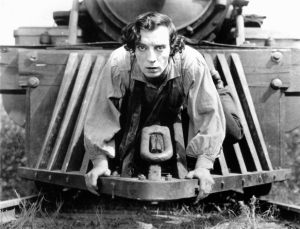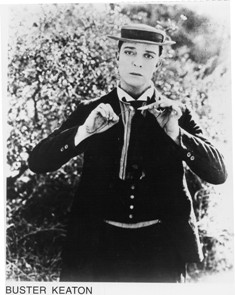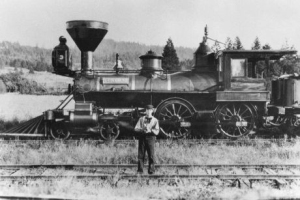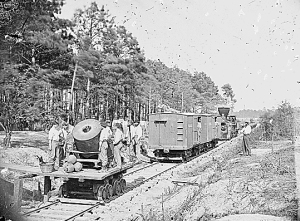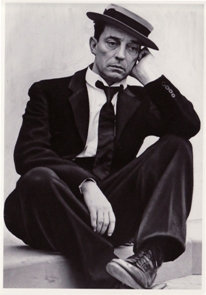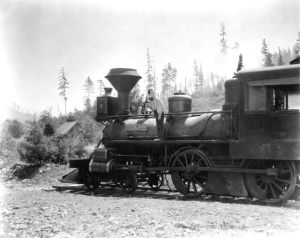Short and Sweet:
Jingle:
Recommended for Ages 8 and Up, and for Parents and Grandparents
What was it really like in the cinema during the silent film era? With the help of silent film musician Wilfried Kaets, we will show you what cinema was like in the days before sound.
The film is set during the American Civil War. Locomotive engineer Johnny has two great loves: his locomotive, “The General,” and his girlfriend, Annabelle. When enemy soldiers steal his train one day, Johnny immediately sets out in pursuit. On foot, with a handcar, and eventually with a second locomotive, he overcomes all the obstacles the enemy throws in his path.
Upon reaching the enemy headquarters, he finds his girlfriend Annabelle, who is trapped on the stolen train. Johnny knows exactly what he needs to do: rescue Annabelle and reclaim his locomotive, “The General”! And Johnny has plenty of devious tricks up his sleeve for stopping enemy trains…
About the film:
On June 8, 1926, filming began. The film was shot on 35mm film using mostly three cameras, sometimes four, with each shot – except for some exceptions – typically filmed with two cameras. As usual, the filming was done without a pre-written script, and Keaton was open to improvisations even during shooting.
At the dramatic climax, a locomotive was to drive over a burning bridge and fall into the abyss. For this scene, Keaton opted not to use a model. Instead, a 70-foot-long railroad bridge was constructed over the river. One of the old locomotives was equipped with a dummy in the cab and set in motion.
In addition to several hundred actors playing Union soldiers in front of the camera, over 3,000 spectators from across the country came to watch the scene, which could only be filmed once. When the locomotive crossed the bridge, which had been set on fire, prepared explosives were detonated. The wreckage of the locomotive remained in the riverbed as a tourist attraction for decades and was only removed during World War II when the steel was needed for the war effort. This shot alone cost around $42,000 – equivalent to approximately $525,000 today – and is considered the most expensive of the entire silent film era.
About:
The work was created at the height of Keaton’s fame and is considered one of the most expensive comedies of the silent film era. The film’s failure with both audiences and critics marked the end of Keaton’s artistic independence. When his now-forgotten silent films were rediscovered in the late 1950s, *The General* was the focus of attention. Since then, the film has been regarded as one of the most significant comedies in film history due to its coherent narrative and ambitious visual design.
Music:
New music by Wilfried Kaets for concert organ, MIDI vibraphone, and percussion.
The music is structurally oriented towards the film music dramaturgy of the silent film era, and also incorporates themes from film archives of the 1920s. However, it is largely a new composition.
This is evident both in the formal aspects, such as the timbre of the MIDI vibraphone, and in the actual musical notation, which presents the contemporary composer without attempting to copy old models. This achieves an exciting balance of “old images” and “new sounds” that do not simply run contrapuntally alongside or against the film but create a dramaturgically cohesive integration.
The silent film has so far been successfully performed in various cinemas, churches, and concert halls in Germany, Luxembourg, and Switzerland. Further concerts are planned.
Register:
Buster Keaton
Joseph Francis Keaton (October 4, 1895, Piqua, Kansas – February 1, 1966, Woodland Hills, California) was an American actor, comedian, and director. Keaton was one of the most successful comedians of the silent film era, alongside Charles Chaplin and Harold Lloyd. Due to his deliberately serious, stoic expression, he was known as “The Great Stone Face” and “The Man Who Never Laughed.” Another trademark was his pork pie hat, a round, flat-brimmed felt hat.
His acrobatic talent led him to a career in vaudeville as a child before he began appearing in films with Roscoe Arbuckle at the age of twenty-one. Three years later, he started producing his own highly successful comedies. In 1924, with *The Navigator*, he achieved a breakthrough and joined the ranks of the most popular comedians of his time, such as Chaplin and Lloyd.
Due to the financial failure of his elaborate film *The General*, Keaton joined MGM in 1928. By 1933, suffering from alcoholism and facing ongoing conflicts with the studio executives, he was dismissed and fell into obscurity. In the 1950s, his technically innovative silent film comedies were rediscovered and celebrated, and they are now considered some of the most significant works in film history.

